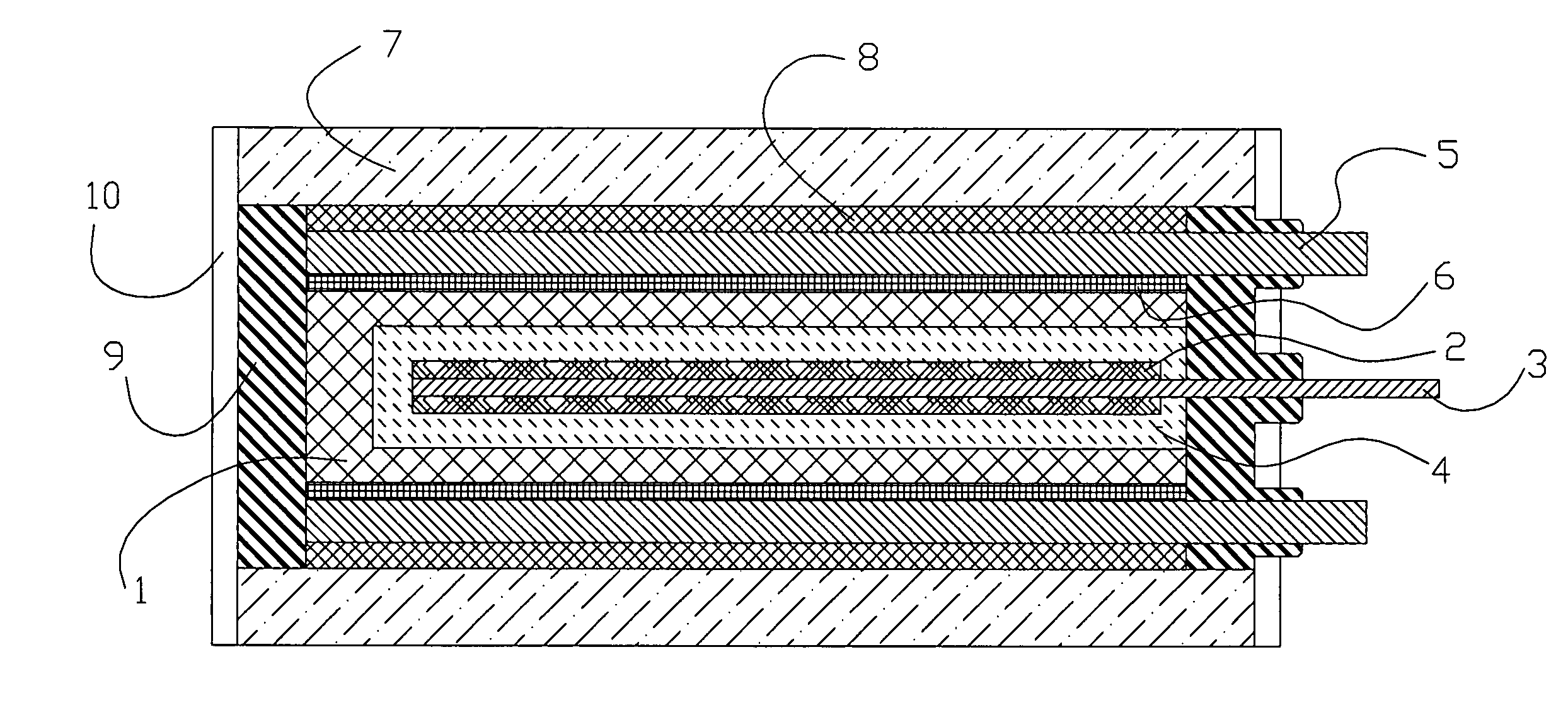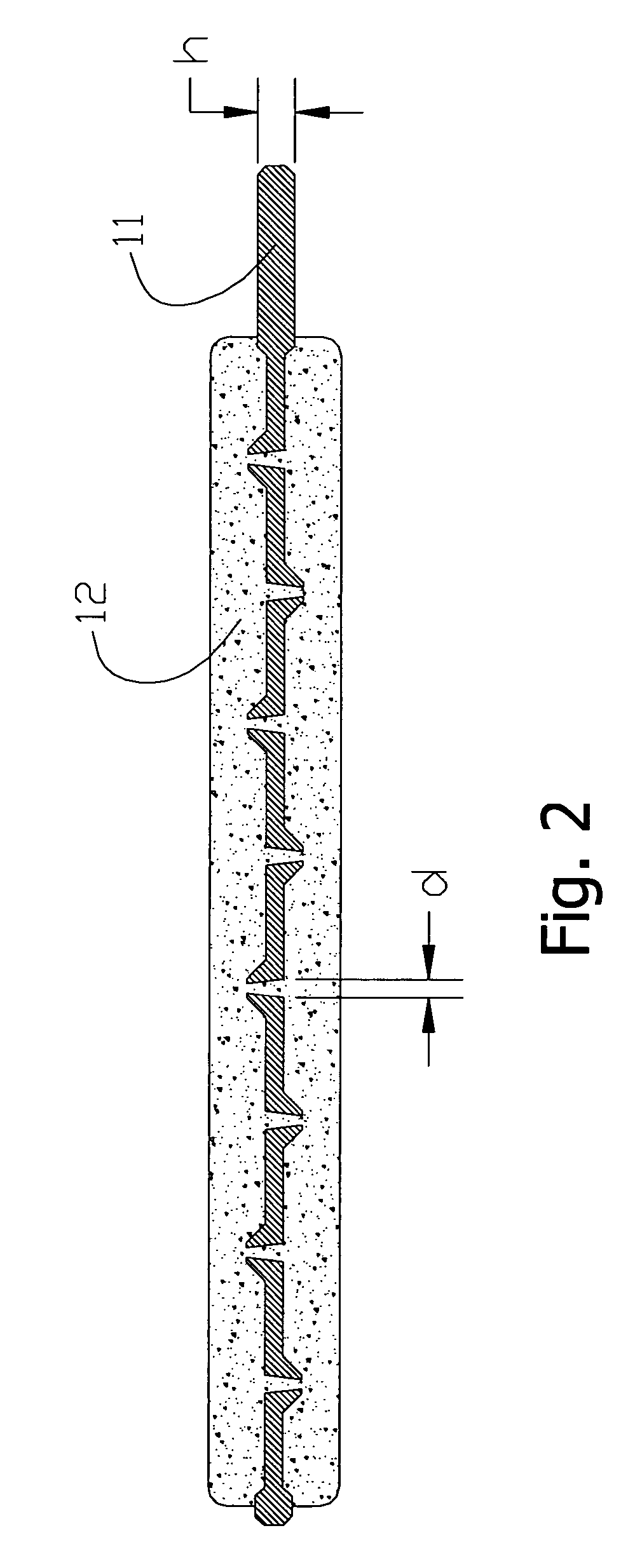Positive electrode of an electric double layer capacitor
a double layer capacitor and positive electrode technology, applied in the direction of capacitor electrodes, electrolytic capacitors, liquid electrolytic capacitors, etc., can solve the problems of prone corrosion or oxidation of the positive electrode of such an edl capacitor, low specific energy, and low discharge and charge currents of edl capacitors employing them, so as to reduce the negative impact of compression on the porosity of the active mass, increase the cycleability of the electrode, and reduce the negative effect of compression
- Summary
- Abstract
- Description
- Claims
- Application Information
AI Technical Summary
Benefits of technology
Problems solved by technology
Method used
Image
Examples
example 1
[0049]Referring first to the positive electrode shown in FIG. 2, the lead foil 11 in this example had dimensions of 70×50 mm and a thickness of 0.15 mm. The lead foil 11 was punctured with a punch having 0.6 mm needles. The surface are of the holes was 20% of the total surface area of the lead foil 11. The active mass 12 was prepared from a mixture of pure chemical substances PbO2 and PbSO4 at a 1:0.8 ratio. The initial state of charge of the negative electrode was taken into account when this ratio was determined. A 3% PTFE binding agent in form of water suspension was added to the paste, as well as 3% of finely cut glass fibres. The paste was applied on both sides of the punctured lead foil 11. The pressure applied was 50 kg / cm2. Sintering temperature was 110° C. At a charged state the porosity was 48%, and the specific gravity after excessive charge was 0.3 g / cm2.
[0050]With further reference to the EDL HEC illustrated in FIG. 1, a negative electrode 1 was made of three layers of ...
example 2
[0051]Again referring first to the positive electrode shown in FIG. 2, the lead foil 11 was made of a lead alloy with 0.7% Sn, 0.05% Cu, and 0.01% Ca. The dimensions of the lead foil 11 were 70×50 mm and the thickness 0.4 mm. It was pierced with a punch having 2-mm borers. The surface area of the holes was 30% of the total surface area of the lead foil 11.
[0052]The initial active mass 12 was made from a paste of 4PbO□PbSO4, which is widely used for formation of positive plates in lead-acid batteries. Proton-exchange polyfluorsulfonic acid of Nafion type was added as a binding agent (2%) as well as 3% of finely cut separator of Grace type. The paste was applied on both sides of the punctured lead foil 11 at total amount of 0.5 g / cm2. It was directly formed within the EDL HEC (refer to FIG. 1). The formation was carried out in 10% sulfuric acid to which 0.5% of phosphoric acid was added. The pressure did not exceed 1 kg / cm2. Porosity of the electrodes after formation amounted to 60%.
[...
example 3
[0054]Again referring to the positive electrode shown in FIG. 2, the lead foil 11 used in this example had dimensions 70×50 mm and a thickness of 0.1 mm. The lead foil 11 was punctured with a punch having 0.5-mm needles. The surface area of the holes was 15% of the total surface area of the lead foil 11. The active mass 12 was taken from preliminary discharged to 30% positive electrodes of commercially available lead-acid battery. The active mass 12 had particle size of 100 to 200 um. A 4% PVDF binding agent in form of water suspension was added. The paste was applied on one side of the punctured lead foil 11 at total amount of 0.07 g / cm2.
[0055]The electrode was dried at room temperature and pressed with 80 kg / cm2. Sintering temperature was 105° C. At charged state the porosity was 55%. Again, the EDL HEC is depicted in FIG. 1. The negative electrode 1 was made of activated carbon ADG with specific surface of 1150 m2 / g. Layers of the dense rubber gaskets 8 were placed on the backsid...
PUM
 Login to View More
Login to View More Abstract
Description
Claims
Application Information
 Login to View More
Login to View More - R&D
- Intellectual Property
- Life Sciences
- Materials
- Tech Scout
- Unparalleled Data Quality
- Higher Quality Content
- 60% Fewer Hallucinations
Browse by: Latest US Patents, China's latest patents, Technical Efficacy Thesaurus, Application Domain, Technology Topic, Popular Technical Reports.
© 2025 PatSnap. All rights reserved.Legal|Privacy policy|Modern Slavery Act Transparency Statement|Sitemap|About US| Contact US: help@patsnap.com



